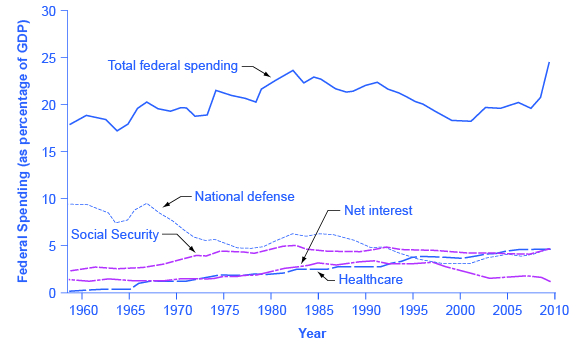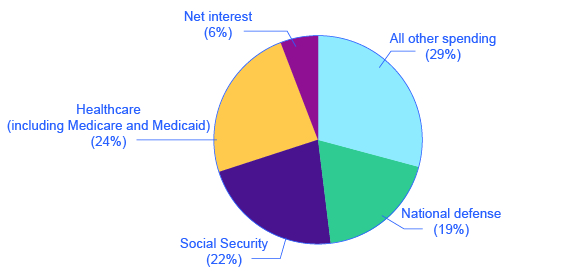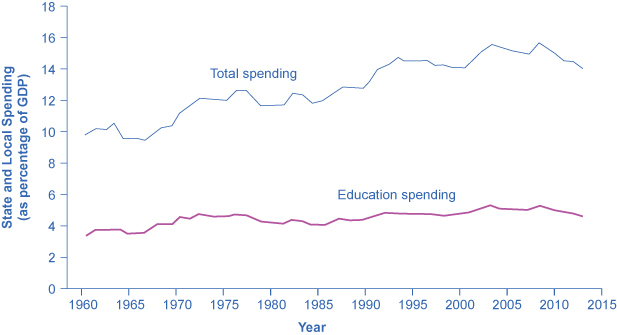If government spending increases, what happens to taxes?
Affiliate xxx. Government Budgets and Financial Policy
30.1 Government Spending
Learning Objectives
By the stop of this department, y'all will exist able to:
- Identify U.South. budget deficit and surplus trends over the by 5 decades
- Explain the differences between the U.S. federal budget, and country and local budgets
Authorities spending covers a range of services provided by the federal, country, and local governments. When the federal authorities spends more money than it receives in taxes in a given year, information technology runs a budget arrears. Conversely, when the government receives more coin in taxes than it spends in a yr, it runs a budget surplus. If government spending and taxes are equal, it is said to take a balanced upkeep. For example, in 2009, the U.S. regime experienced its largest budget deficit ever, as the federal government spent $1.iv trillion more than it collected in taxes. This deficit was almost 10% of the size of the U.S. Gross domestic product in 2009, making it by far the largest upkeep deficit relative to Gross domestic product since the mammoth borrowing used to finance World War Two.
This section presents an overview of government spending in the United States.
Total U.Southward. Government Spending
Federal spending in nominal dollars (that is, dollars not adjusted for inflation) has grown by a multiple of more than than 38 over the final iv decades, from $93.4 billion in 1960 to $3.ix trillion in 2014. Comparing spending over time in nominal dollars is misleading because it does not take into business relationship aggrandizement or growth in population and the real economic system. A more useful method of comparison is to examine regime spending as a percent of Gdp over time.
The top line in Figure 1 shows the level of federal spending since 1960, expressed as a share of Gdp. Despite a widespread sense among many Americans that the federal government has been growing steadily larger, the graph shows that federal spending has hovered in a range from 18% to 22% of GDP most of the time since 1960. The other lines in Figure 1 evidence the major federal spending categories: national defence force, Social Security, health programs, and involvement payments. From the graph, we see that national defence force spending as a share of GDP has generally declined since the 1960s, although there were some upward bumps in the 1980s buildup nether President Ronald Reagan and in the aftermath of the terrorist attacks on September eleven, 2001. In dissimilarity, Social Security and healthcare accept grown steadily as a percent of Gross domestic product. Healthcare expenditures include both payments for senior citizens (Medicare), and payments for low-income Americans (Medicaid). Medicaid is also partially funded by state governments. Interest payments are the concluding main category of authorities spending shown in the figure.

Each year, the government borrows funds from U.S. citizens and foreigners to cover its budget deficits. It does this past selling securities (Treasury bonds, notes, and bills)—in essence borrowing from the public and promising to repay with interest in the hereafter. From 1961 to 1997, the U.South. government has run budget deficits, and thus borrowed funds, in almost every year. It had budget surpluses from 1998 to 2001, so returned to deficits.
The interest payments on past federal government borrowing were typically 1–two% of Gdp in the 1960s and 1970s but then climbed higher up three% of GDP in the 1980s and stayed in that location until the late 1990s. The government was able to repay some of its by borrowing by running surpluses from 1998 to 2001 and, with help from low interest rates, the interest payments on past federal government borrowing had fallen back to 1.4% of GDP by 2012.
We investigate the patterns of government borrowing and debt in more detail afterward in this chapter, but first nosotros need to clarify the difference between the deficit and the debt. The deficit is not the debt. The difference between the deficit and the debt lies in the fourth dimension frame. The government deficit (or surplus) refers to what happens with the federal authorities upkeep each year. The government debt is accumulated over fourth dimension; it is the sum of all past deficits and surpluses. If you infringe $ten,000 per year for each of the iv years of college, you might say that your almanac deficit was $10,000, but your accumulated debt over the iv years is $xl,000.
These four categories—national defense, Social Security, healthcare, and interest payments—account for roughly 73% of all federal spending, as Effigy two shows. The remaining 27% wedge of the pie nautical chart covers all other categories of federal regime spending: international affairs; science and applied science; natural resources and the environment; transportation; housing; education; income back up for the poor; community and regional development; constabulary enforcement and the judicial organization; and the administrative costs of running the authorities.

Country and Local Government Spending
Although federal government spending often gets most of the media attending, state and local government spending is also substantial—at about $3.i trillion in 2014. Figure 3 shows that country and local authorities spending has increased during the final four decades from around viii% to around 14% today. The single biggest item is education, which accounts for about one-third of the total. The remainder covers programs like highways, libraries, hospitals and healthcare, parks, and police and fire protection. Unlike the federal government, all states (except Vermont) have balanced budget laws, which means any gaps between revenues and spending must be closed by higher taxes, lower spending, cartoon down their previous savings, or some combination of all of these.

U.S. presidential candidates frequently run for function pledging to improve the public schools or to get tough on crime. However, in the U.Southward. system of government, these tasks are primarily the responsibilities of state and local governments. Indeed, in fiscal twelvemonth 2014 state and local governments spent about $840 billion per year on education (including Chiliad–12 and college and academy education), compared to only $100 billion by the federal authorities, according to usgovernmentspending.com. In other words, well-nigh xc cents of every dollar spent on didactics happens at the country and local level. A politician who really wants hands-on responsibleness for reforming education or reducing crime might do ameliorate to run for mayor of a large city or for state governor rather than for president of the Us.
Key Concepts and Summary
Fiscal policy is the prepare of policies that relate to federal government spending, taxation, and borrowing. In recent decades, the level of federal government spending and taxes, expressed as a share of GDP, has non changed much, typically fluctuating between about 18% to 22% of GDP. Nonetheless, the level of land spending and taxes, every bit a share of GDP, has risen from about 12–13% to well-nigh xx% of Gross domestic product over the last four decades. The four chief areas of federal spending are national defence, Social Security, healthcare, and interest payments, which together business relationship for almost 70% of all federal spending. When a regime spends more than information technology collects in taxes, it is said to have a budget arrears. When a authorities collects more than in taxes than it spends, it is said to have a budget surplus. If government spending and taxes are equal, it is said to take a balanced budget. The sum of all past deficits and surpluses make up the government debt.
Self-Check Questions
- When governments run budget deficits, how do they make upwardly the differences between tax revenue and spending?
- When governments run budget surpluses, what is done with the actress funds?
- Is it possible for a nation to run budget deficits and yet take its debt/GDP ratio fall? Explain your answer. Is it possible for a nation to run budget surpluses and still have its debt/GDP ratio rise? Explain your answer.
Review Questions
- Give some examples of changes in federal spending and taxes by the regime that would be fiscal policy and some that would not.
- Have the spending and taxes of the U.S. federal authorities generally had an upward or a downward trend in the concluding few decades?
- What are the main categories of U.S. federal government spending?
- What is the difference between a budget deficit, a balanced budget, and a budget surplus?
- Have spending and taxes by state and local governments in the United States had a generally upwards or downwardly tendency in the last few decades?
Critical Thinking Questions
- Why is government spending typically measured every bit a pct of GDP rather than in nominal dollars?
- Why are expenditures such as offense prevention and education typically done at the state and local level rather than at the federal level?
- Why is spending by the U.South. regime on scientific enquiry at NASA fiscal policy while spending by the University of Illinois is not fiscal policy? Why is a cut in the payroll revenue enhancement fiscal policy whereas a cut in a state income tax is not fiscal policy?
Problems
A government starts off with a total debt of $3.5 billion. In year one, the regime runs a deficit of $400 one thousand thousand. In yr 2, the government runs a deficit of $one billion. In twelvemonth three, the government runs a surplus of $200 1000000. What is the total debt of the authorities at the end of year iii?
References
Kramer, Mattea, et. al. A People'due south Guide to the Federal Budget. National Priorities Project. Northampton: Interlink Books, 2012.
Kurtzleben, Danielle. "x States With The Largest Upkeep Shortfalls." U.S. News & World Report. Januray 14, 2011. http://www.usnews.com/news/manufactures/2011/01/xiv/10-states-with-the-largest-budget-shortfalls.
Miller, Rich, and William Selway. "U.S. Cities and States First Spending Again." BloombergBusinessweek, January 10, 2013. http://world wide web.businessweek.com/articles/2013-01-10/u-dot-southward-dot-cities-and-states-start-spending-over again.
Weisman, Jonathan. "After Yr of Working Effectually Federal Cuts, Agencies Confront Fewer Options." The New York Times, October 26, 2013. http://www.nytimes.com/2013/10/27/us/politics/after-year-of-working-around-federal-cuts-agencies-face-fewer-options.html?_r=0.
Chantrill, Christopher. USGovernmentSpending.com. "Government Spending Details: United states Federal State and Local Government Spending, Fiscal Yr 2013." http://www.usgovernmentspending.com/year_spending_2013USbn_15bs2n_20.
Glossary
- balanced budget
- when government spending and taxes are equal
- budget deficit
- when the federal government spends more money than it receives in taxes in a given year
- budget surplus
- when the authorities receives more than money in taxes than it spends in a year
Solutions
Answers to Self-Check Questions
- The government borrows funds past selling Treasury bonds, notes, and bills.
- The funds can be used to pay down the national debt or else exist refunded to the taxpayers.
- Yes, a nation can run budget deficits and see its debt/GDP ratio autumn. In fact, this is not uncommon. If the arrears is small in a given year, than the addition to debt in the numerator of the debt/Gdp ratio will be relatively small, while the growth in Gross domestic product is larger, and so the debt/GDP ratio declines. This was the experience of the U.S. economic system for the menses from the end of Earth War II to almost 1980. It is also theoretically possible, although not likely, for a nation to have a upkeep surplus and run across its debt/Gdp ratio ascension. Imagine the case of a nation with a pocket-sized surplus, but in a recession year when the economy shrinks. It is possible that the decline in the nation'southward debt, in the numerator of the debt/GDP ratio, would exist proportionally less than the fall in the size of Gdp, so the debt/Gdp ratio would rise.
Source: https://opentextbc.ca/principlesofeconomics/chapter/30-1-government-spending/
0 Response to "If government spending increases, what happens to taxes?"
Post a Comment